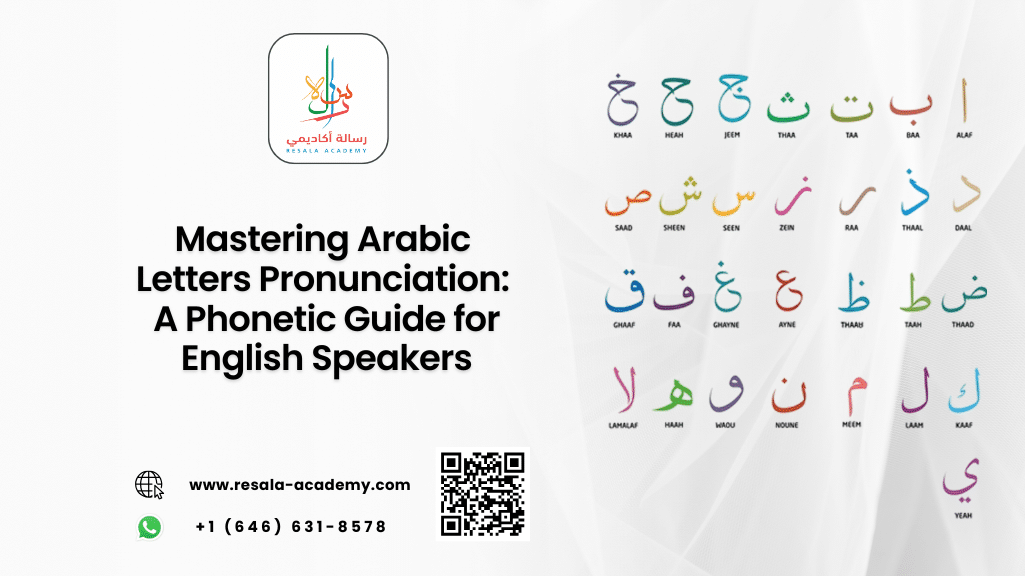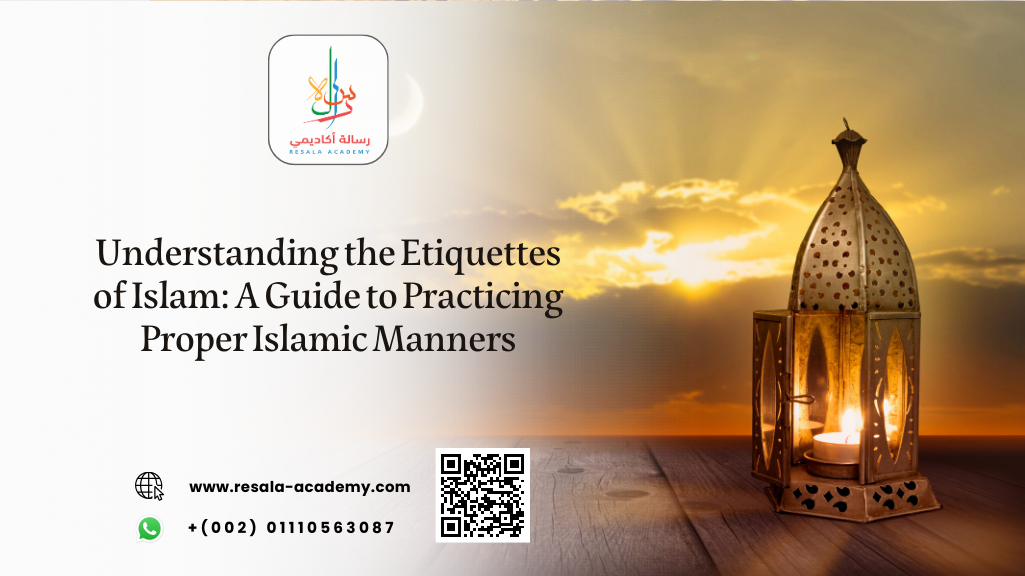Table of Contents
Mastering Arabic Letters Pronunciation: A Phonetic Guide for English Speakers
Learning a new language is always a rewarding journey, but when it comes to Arabic, the path is both fascinating and uniquely challenging. One of the most critical aspects of learning Arabic is mastering the Arabic letters pronunciation.
For English speakers, the Arabic script can initially appear daunting due to its distinct phonetic system and unfamiliar sounds. However, with the right guidance, tools, and practice, anyone can develop a clear and confident pronunciation.
In this comprehensive guide, we’ll explore the phonetic intricacies of the Arabic alphabet, provide practical pronunciation tips, and introduce you to Resala Academy—a leading online platform that specializes in teaching Arabic and Quran to non-native speakers.
Why Arabic Letters Pronunciation Matters
Correct pronunciation is the foundation of effective communication in any language. In Arabic, it becomes even more crucial due to the language’s rich phonemic diversity. Mispronouncing a single letter can completely alter the meaning of a word. For instance:
- قلب (qalb) – means “heart”
- كلب (kalb) – means “dog”
The only difference is the pronunciation of the letter ق (qaf) versus ك (kaf). This example highlights the importance of mastering each letter’s unique sound.
Understanding the Arabic Alphabet
The Arabic alphabet consists of 28 letters, written from right to left. Each letter can have up to four different forms depending on its position in the word (initial, medial, final, or isolated).
Here’s a quick overview of the Arabic letters:
| Arabic Letter | Name | English Approximation |
|---|---|---|
| أ | Alif | A (as in apple) |
| ب | Ba | B (as in bat) |
| ت | Ta | T (as in top) |
| ث | Tha | Th (as in think) |
| ج | Jeem | J (as in jam) |
| ح | Haa | Deep H (breathy) |
| خ | Khaa | Harsh H (like “loch”) |
| د | Dal | D (as in dog) |
| ذ | Dhal | Th (as in this) |
| ر | Ra | Rolled R |
| ز | Zay | Z (as in zoo) |
| س | Seen | S (as in sun) |
| ش | Sheen | Sh (as in ship) |
| ص | Saad | Heavy S |
| ض | Daad | Heavy D (unique sound) |
| ط | Taa | Heavy T |
| ظ | Zaa | Heavy Z |
| ع | Ain | Deep throat sound |
| غ | Ghayn | Rasping G |
| ف | Fa | F (as in fan) |
| ق | Qaf | Deep K (from throat) |
| ك | Kaf | K (as in kite) |
| ل | Lam | L (as in love) |
| م | Meem | M (as in man) |
| ن | Noon | N (as in net) |
| هـ | Ha | H (as in hat) |
| و | Waw | W (as in water) |
| ي | Ya | Y (as in yellow) |
Read more about: How to Teach Kids the First Arabic Letter Crossword Clue Through Fun Language Games
Key Challenges for English Speakers
1. Emitting Sounds from the Throat
Arabic includes several pharyngeal and uvular sounds that don’t exist in English. Letters like ع (Ain) and غ (Ghayn) require using parts of the throat that English speakers are not accustomed to.
2. Distinguishing Emphatic Letters
Arabic has a set of emphatic letters—ص (Saad), ض (Daad), ط (Taa), and ظ (Zaa)—which are pronounced with a heavier, more forceful tone. These can be difficult to distinguish from their non-emphatic counterparts.
3. Short Vowels and Diacritics
Unlike English, Arabic uses short vowels indicated by diacritical marks (fatha, kasra, damma). These are essential for correct pronunciation but are often omitted in written texts, making pronunciation more challenging for learners.
Read more about: How to Identify and Memorize the Heavy Letters in Arabic Fast
Phonetic Tips to Master Arabic Letters
Use IPA (International Phonetic Alphabet)
Learning the IPA symbols for Arabic sounds can help you understand how to position your tongue and vocal cords.
Practice with Native Speakers
Listening and mimicking native pronunciation is one of the most effective ways to improve. Platforms like Resala Academy offer live sessions with native Arabic teachers.
Record and Compare
Use apps to record your pronunciation and compare it with native speakers. This helps identify subtle pronunciation errors.
Focus on Minimal Pairs
Practice words that differ by only one letter to fine-tune your ear. For example:
- سَمَاء (samaa’) – sky
- صَمَاء (samaa’) – deaf (feminine)
Arabic Letters with No English Equivalent
Some Arabic sounds are completely foreign to English speakers. Here’s how to approach them:
ع (Ain)
- Pronounced deep in the throat.
- Example: عِلْم (ʿilm) – knowledge
- Tip: Try to produce a voiced sound from the middle of your throat.
غ (Ghayn)
- Similar to the French “r” in “rue.”
- Example: غُرْفَة (ghurfa) – room
ق (Qaf)
- A voiceless uvular plosive.
- Example: قَلْب (qalb) – heart
ح (Haa)
- A voiceless pharyngeal fricative.
- Example: حُبّ (hubb) – love
Vowels and Diacritics: The Unsung Heroes
Arabic has three short vowels:
- Fatha ( َ ) – “a” as in “cat”
- Kasra ( ِ ) – “i” as in “sit”
- Damma ( ُ ) – “u” as in “put”
And three long vowels:
- ا (Alif) – long “a”
- و (Waw) – long “u”
- ي (Ya) – long “i”
Understanding these is essential for accurate pronunciation and comprehension.
The Role of Tajweed in Arabic Pronunciation
For learners interested in Quranic Arabic, Tajweed is the science of proper pronunciation during Quran recitation. It emphasizes the articulation points (makharij) and characteristics (sifat) of each letter.
Resala Academy offers specialized online Tajweed courses that help students perfect their pronunciation according to classical Islamic traditions.
Practice Makes Perfect: Example Words by Letter
Here are a few examples to help you practice:
| Letter | Arabic Word | English Meaning | Notes |
|---|---|---|---|
| ب | بَيْت | House | “B” sound |
| ج | جَمِيل | Beautiful | “J” as in jam |
| د | دَرْس | Lesson | “D” as in dog |
| ر | رَجُل | Man | Rolled R |
| س | سَيَّارَة | Car | “S” as in sun |
| ط | طَبِيب | Doctor | Emphatic T |
| ق | قَلَم | Pen | Deep K sound |
Advanced Articulation Techniques for Arabic Letters Pronunciation
To truly excel in mastering Arabic letters pronunciation, learners must go beyond basic repetition and engage in advanced articulation techniques that refine sound production and vocal control. These methods are particularly effective for non-native speakers aiming for native-like fluency:
Vocal Warm-Ups for Throat Sounds
▪️ Begin each practice session with vocal exercises that target the pharyngeal and uvular regions.
▪️ Humming and deep-throat breathing can prepare your vocal cords for complex sounds like ع (Ain) and غ (Ghayn).
▪️ These warm-ups reduce strain and improve clarity in pronunciation.
Mirror and Mouth Mapping Practice
▪️ Use a mirror to observe the tongue and lip movements associated with each Arabic letter.
▪️ Map out the articulation points (makharij) visually and kinesthetically to internalize correct positioning.
▪️ This technique is especially useful for distinguishing between similar sounds like س (Seen) and ص (Saad).
Phonetic Shadowing with Audio Resources
▪️ Listen to native speakers and immediately repeat after them using audio tools or language apps.
▪️ Focus on mimicking intonation, rhythm, and stress patterns to enhance your Arabic pronunciation accuracy.
▪️ Shadowing is a proven method for developing muscle memory in speech.
Cognitive Strategies to Internalize Arabic Phonemes
Beyond physical articulation, cognitive strategies play a vital role in mastering Arabic phonemes and improving long-term retention of correct Arabic letters pronunciation. These mental techniques help learners build a deeper connection with the language’s sound system:
Sound Association and Mnemonics
▪️ Create mental associations between Arabic letters and familiar English sounds or imagery.
▪️ For example, link خ (Khaa) to the Scottish “loch” to remember its throaty texture.
▪️ Mnemonics accelerate recall and reinforce correct articulation.
Minimal Pair Drills with Contextual Usage
▪️ Practice contrasting word pairs that differ by one phoneme to sharpen auditory discrimination.
▪️ Use these pairs in real-life sentences to understand their contextual meaning and pronunciation impact.
▪️ Example:
سِيرَة (seerah) – biography
صِيرَة (seerah) – (non-standard, but useful for contrast)
Spaced Repetition Systems (SRS)
▪️ Leverage SRS tools to review and reinforce difficult sounds over time.
▪️ Apps like Anki or Memrise can be customized with audio flashcards for each Arabic letter.
▪️ This method ensures consistent exposure and mastery of nuanced Arabic articulation.
These advanced strategies, when combined with expert instruction from platforms like Resala Academy, empower learners to not only pronounce Arabic letters correctly but also internalize them as part of their linguistic identity.
Why Choose Resala Academy?
Resala Academy is a trusted name in online Arabic education. Here’s why learners around the world choose them:
✅ Native Arabic-speaking instructors
✅ Personalized one-on-one lessons
✅ Flexible scheduling
✅ Comprehensive curriculum including Tajweed, grammar, and conversation
✅ Affordable pricing
Whether you’re a beginner or looking to refine your pronunciation, Resala Academy offers a structured and supportive environment to help you succeed.
Speak Like a Native: Your Journey Begins Here
Imagine being able to read the Quran fluently, converse confidently with native speakers, and truly understand the beauty of the Arabic language. That journey begins with mastering pronunciation—and the best place to start is Resala Academy.
Join thousands of learners worldwide who have transformed their Arabic skills through expert-led classes, interactive lessons, and a community that supports your growth.
👉 Ready to unlock the secrets of Arabic pronunciation? Enroll in Resala Academy today!
Frequently Asked Questions (FAQs)
1. How many Arabic letters are there?
There are 28 letters in the Arabic alphabet. Each letter has a unique sound and can change form depending on its position in a word. Learn more about the Arabic alphabet in English here.
2. What is the hardest Arabic letter to pronounce for English speakers?
Many learners find ع (Ain) and غ (Ghayn) the most difficult due to their throat-based articulation. Regular practice with native speakers, such as those at Resala Academy, can help overcome this challenge.
3. Can I learn Arabic pronunciation without learning to write?
Yes, but it’s not recommended. Understanding how letters are written helps reinforce their pronunciation. Resala Academy integrates both reading and speaking skills for a holistic learning experience.
4. What is Tajweed, and why is it important?
Tajweed is the set of rules for proper pronunciation during Quran recitation. It ensures clarity, accuracy, and reverence. Resala Academy offers specialized Tajweed courses for non-native speakers.
5. How long does it take to master Arabic pronunciation?
It varies by individual, but with consistent practice and expert guidance—like that offered by Resala Academy—you can achieve noticeable improvement in a few months.
Conclusion
Mastering Arabic letters pronunciation is more than just a linguistic skill—it’s a gateway to understanding a rich cultural and spiritual heritage. While the journey may seem challenging, the rewards are immense: deeper comprehension, meaningful communication, and a profound connection to the Arabic-speaking world.
With expert guidance from Resala Academy, you can navigate this journey with confidence. Their tailored courses, skilled instructors, and flexible learning options make them the ideal partner for any non-native speaker eager to master Arabic.
Start your journey today and let the beauty of Arabic unfold—one letter at a time. Explore more at Resala Academy and take your first step toward fluency.




